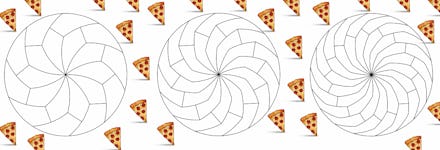There's a Mathematically Perfect Way to Slice Pizza — Can You Do It?

On the surface, pizza and mathematics might seem to go together like chalk and cheese, but they actually have quite a history together.
Recently, two mathematicians from the University of Liverpool banded together to expand the pizza math-iverse, and the results were deliciously eye-catching.
Behold, the coolest new way to slice pizza:
In a paper titled "Infinite families of monohedral disk tilings," Joel Haddley and Stephen Worsley devised a more complex — yet mathematically sound — way to divide up a pizza. Earlier research had proven that it was possible to cut a pizza into six curved pieces, which could be further split in two to produce 12 of the same-sized slices.
It looks like this:
Building on the above method, Haddley and Worsley proved that you can slice up a pizza in curved, sythe-shaped pieces with odd-numbered straight sides. Called 5-gons, 7-gons, 9-gons and so on, the pieces can be further split in two to produce double the number of equally sized pieces.
Check it out:
"Mathematically there is no limit whatsoever," Haddley told New Scientist, which means you can theoretically cut your pizza into an infinite number of slices. As New Scientist notes, however, it'll probably be difficult to go beyond nine parts.
While this kind of witchcraft might seem completely nonsensical, there might be some good uses for it: If everyone with whom you're dining wants different toppings — or some people hate the crust — it's much easier to make people happy using this method.
"I've no idea whether there are any applications at all to our work outside of pizza-cutting," Haddley told New Scientist. But the paper is "interesting mathematically, and you can produce some nice pictures."
Praise the pizza gods.
h/t Gizmodo